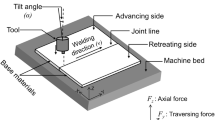Abstract
The manuscript reports on detection of defect that arises during friction stir welding using continuous wavelet transform (CWT) on force signal. The vertical force during welding undergoes sudden change due to presence of defects. These localized defects are detected accurately with the help of continuous wavelet transform scalogram (CWT coefficients’ gray scale image). Statistical feature of variance is used on scale of 1 of transformed signal to localize the defects. The experiments of welding are conducted on the work piece of AA 1100 with varying tool rotational speed (1000, 2000, 3000 rpm) and transverse velocity (50, 75 and 125 mm/min). The manuscript also presents the comparison of results obtained using discrete wavelet transform and CWT of force signals and shows better localization and determination of degree of defect are possible through CWT analysis.













Similar content being viewed by others
References
Bhat, N. N., Kumari, K., Dutta, S., Pal, S. K., & Pal, S. (2015). Friction stir weld classification by applying wavelet analysis and support vector machine on weld surface images. Journal of Manufacturing Processes, 20, 274–281. doi:10.1016/j.jmapro.2015.07.002.
Chen, C., Kovacevic, R., & Jandgric, D. (2003). Wavelet transform analysis of acoustic emission in monitoring friction stir welding of 6061 aluminum. International Journal of Machine Tools and Manufacture, 43(13), 1383–1390. doi:10.1016/S0890-6955(03)00130-5.
Chen, H. B., Yan, K., Lin, T., Chen, S.-B., Jiang, C.-Y., & Zhao, Y. (2006). The investigation of typical welding defects for 5456 aluminum alloy friction stir welds. Materials Science and Engineering: A, 433(1–2), 64–69. doi:10.1016/j.msea.2006.06.056.
Cui, L., Yang, X., Xie, Y., Hou, X., & Song, Y. (2013). Process parameter influence on defects and tensile properties of friction stir welded T-joints on AA6061-T4 sheets. Materials and Design, 51, 161–174. doi:10.1016/j.matdes.2013.04.013.
Cui, L., Yang, X., Zhou, G., Xu, X., & Shen, Z. (2012). Characteristics of defects and tensile behaviors on friction stir welded AA6061-T4 T-joints. Materials Science and Engineering: A, 543, 58–68. doi:10.1016/j.msea.2012.02.045.
Jain, R., Kumari, K., Kesharwani, R. K., Kumar, S., Pal, S. K., & Singh, S. B., et al. (2015). Friction stir welding: Scope and recent developement. In Mordern manufacturing engineering edited by J. Paulo Davim, (Springer) (pp. 179–228). doi:10.1007/978-3-319-20152-8.
Jain, R., Pal, S. K., & Singh, S. B. (2016). A study on the variation of forces and temperature in a friction stir welding process: A finite element approach. Journal of Manufacturing Processes, 23, 278–286. doi:10.1016/j.jmapro.2016.04.008.
Jata, K. V., & Semiatin, S. L. (2000). Continuous dynamic recrystallization during friction stir welding of high strength aluminum alloys. Scripta Materialia, 43(8), 743–749. doi:10.1016/S1359-6462(00)00480-2.
Kilby, J., & Hosseini, H. G. (2006). Extracting effective features of SEMG using continuous wavelet transform. In Annual international conference of the IEEE engineering in medicine and biology—proceedings (pp. 1704–1707. doi:10.1109/IEMBS.2006.260064.
Kim, Y. G., Fujii, H., Tsumura, T., Komazaki, T., & Nakata, K. (2006). Three defect types in friction stir welding of aluminum die casting alloy. Materials Science and Engineering: A, 415(1–2), 250–254. doi:10.1016/j.msea.2005.09.072.
Kumar, U., Yadav, I., Kumari, S., Kumari, K., Ranjan, N., Kesharwani, R. K., et al. (2015). Defect identification in friction stir welding using discrete wavelet analysis. Advances in Engineering Software, 85, 43–50. doi:10.1016/j.advengsoft.2015.02.001.
Leonard, A. J., & Lockyer, S. A. (2003). Flaws in friction stir welds. In 4th international symposium on friction stir welding, USA (pp. 14–16).
Li, B., Shen, Y., & Hu, W. (2011). The study on defects in aluminum 2219–T6 thick butt friction stir welds with the application of multiple non-destructive testing methods. Materials and Design, 32(4), 2073–2084. doi:10.1016/j.matdes.2010.11.054.
Mandache, C., Levesque, D., Dubourg, L., & Gougeon, P. (2012). Non-destructive detection of lack of penetration defects in friction stir welds. Science and Technology of Welding and Joining, 17(4), 295–303. doi:10.1179/1362171812Y.0000000007.
Qian, J., Li, J., Sun, F., Xiong, J., Zhang, F., & Lin, X. (2013). An analytical model to optimize rotation speed and travel speed of friction stir welding for defect-free joints. Scripta Materialia, 68(3–4), 175–178. doi:10.1016/j.scriptamat.2012.10.008.
Ranjan, R., Khan, A. R., Parikh, C., Jain, R., Mahto, R. P., Pal, S., et al. (2016). Classification and identification of surface defects in friction stir welding: An image processing approach. Journal of Manufacturing Processes, 22, 237–253. doi:10.1016/j.jmapro.2016.03.009.
Rosado, L. S., Santos, T. G., Piedade, M., Ramos, P. M., & Vilaça, P. (2010). Advanced technique for non-destructive testing of friction stir welding of metals. Measurement, 43(8), 1021–1030. doi:10.1016/j.measurement.2010.02.006.
Saeid, T., Abdollah-zadeh, A., & Sazgari, B. (2010). Weldability and mechanical properties of dissimilar aluminum-copper lap joints made by friction stir welding. Journal of Alloys and Compounds, 490(1–2), 652–655. doi:10.1016/j.jallcom.2009.10.127.
Saravanan, T., Das, H., Arunmuthu, K., Philip, J., Rao, B. P. C., Jayakumar, T., et al. (2014). Evaluation of dissimilar friction stir lap joints using digital X-ray radiography. Science and Technology of Welding and Joining, 19(2), 125–132. doi:10.1179/1362171813Y.0000000172.
Soundararajan, V., Atharifar, H., & Kovacevic, R. (2006). Monitoring and processing the acoustic emission signals from the friction-stir-welding process. Proceedings of the Institution of Mechanical Engineers Part B-Journal of Engineering Manufacture, 220(10), 1673–1685. doi:10.1243/09544054JEM586.
Stournaras, A., Stavropoulos, P., Salonitis, K., & Chryssolouris, G. (2009). An investigation of quality in CO2 laser cutting of aluminum. CIRP Journal of Manufacturing Science and Technology, 2(1), 61–69. doi:10.1016/j.cirpj.2009.08.005.
Thomas, W., Nicholas, E., Needham, J., Murch, M., Temple, S. P., & Dawes, C. (1991). International patent application no. PCT/GB92/02203 and GB patent application number 9125978.9.
Yu, R. Q., Hu, B., & Zou, H. C. (2012). Magnetic detection technology for tiny flaws in FSW of aluminium alloy. Science and Technology of Welding and Joining, 17(7), 534–538. doi:10.1179/1362171812Y.0000000043.
Author information
Authors and Affiliations
Corresponding author
Rights and permissions
About this article
Cite this article
Kumari, S., Jain, R., Kumar, U. et al. Defect identification in friction stir welding using continuous wavelet transform. J Intell Manuf 30, 483–494 (2019). https://doi.org/10.1007/s10845-016-1259-1
Received:
Accepted:
Published:
Issue Date:
DOI: https://doi.org/10.1007/s10845-016-1259-1




